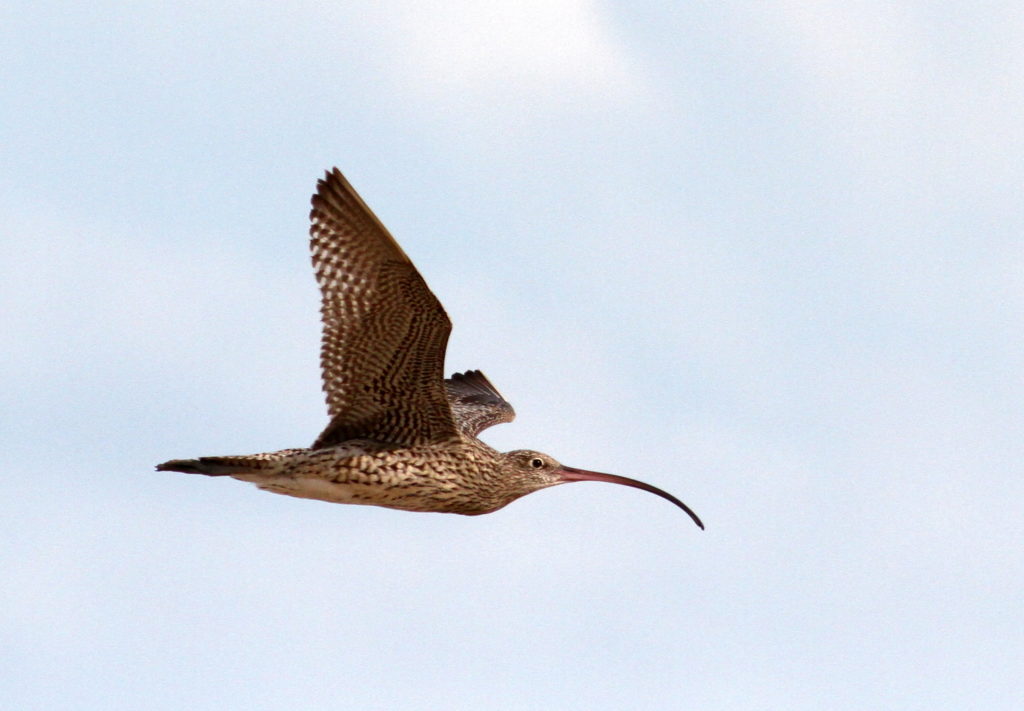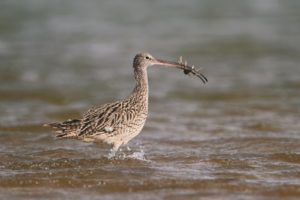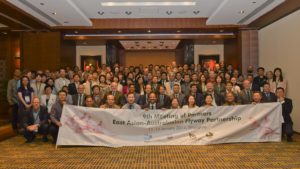Micha Jackson, Magazine of the Threatened Species Recovery Hub
The Far Eastern Curlew is a species of migratory shorebird, with a migration that can truly be described as spectacular. Every year they travel from their non-breeding grounds in the southern hemisphere to breed in boreal marshlands of the northern hemisphere. But, as Micha Jackson from the Threatened Species Recovery Hub of the Australian Government’s National Environmental Science Programme explains, this shorebird is in trouble on multiple fronts.

The Far Eastern Curlew flies thousands of kilometres each year as it migrates from the southern hemisphere to the northern hemisphere (and back again). Its numbers have plummeted in recent years. Image: Amanda Lilleyman
This is a story about saving a migratory shorebird called the Far Eastern Curlew, though the challenges it faces are shared by many migratory bird species. Central to engaging with these challenges is an understanding of the animal’s migration route. Different species of migratory shorebird have their own migration pathway and these routes criss-cross the globe. Different groups of species follow geographically segregated ‘flyways’.
The flyway used by the Far Eastern Curlew is referred to as the ‘East Asian-Australasian Flyway’ (EAAF). Its northern end (where migratory shorebird species breed) includes parts of Russia, China, Mongolia and Alaska, and its southern end (non-breeding habitat) includes parts of south-east Asia, Australia and New Zealand. Between these end points lies much of east and south-east Asia as well as the islands of the western Pacific (where some birds spend the non-breeding season).
More than 50 species of migratory shorebird use the EAAF, consisting of millions and millions of birds, and they pass through more than 20 countries every year.
The Far Eastern Curlew is endemic to the EAAF. That means it occurs nowhere else on Earth. It breeds at relatively southern latitudes (compared with other shorebird species) in rather small marshy areas of Russia and northern China.
Tracking studies over the last 30 years have taught us much about its life-cycle. These studies include the resighting, and recording and reporting of bands and flags attached to the legs of curlews as they move through the flyway, and the use of geo-locators and satellite transmitters.
It turns out that as far as we can tell, the entire population of Far Eastern Curlew passes through the Yellow Sea/Bohai Sea region (encompassing coastal areas of China, the Democratic People’s Republic of Korea and the Republic of Korea) during both northward and southward migrations. This makes this region an absolutely critical stopover for curlews to rest and refuel during their gruelling long-distance migration flights.
During the non-breeding season, the birds congregate largely in Australia, with up to about three quarters of them waiting out the northern winter here (most of the rest go to the Philippines, Indonesia and PNG though non-breeding areas outside Australia require further study).
Under a dark cloud
Given its large size and striking appearance, the Far Eastern Curlew is a surprisingly easy bird for the casual onlooker to miss. Highly sensitive to disturbance, it will generally flee from people and dogs when they are more than a hundred metres away, and its brown mottled feathers mean that it blends in well with the sandy coastal habitats it generally inhabits in Australia.
And it’s highly likely it will be harder to find in years to come as this amazing bird has suffered rapid and dramatic population declines in recent decades. The IUCN Red List, which assesses the global status of species, listed it as Least Concern in 2004, but it was rapidly upgraded to Vulnerable in 2010 and to Endangered in 2015. Recent research confirmed an annual decline of almost 6% equating to a loss of a staggering 82% of the species over just three generations. The Far Eastern Curlew was listed as Critically Endangered in Australia in 2016. What’s the story?
A key driver in the decline of Far Eastern curlew is the extensive loss of mudflat habitat along its migration route, particularly in the Yellow Sea region. More than half of it has disappeared over the last 50 years. Large-scale coastal development, which includes reclamation of intertidal flats and their transition from soft, food-filled mud into hardened land surface capable of supporting housing developments, plays a large role in driving this loss of habitat. But this transformation is compounded by other factors including loss of sedimentation from rivers that have been extensively dammed, and escalating sea-level rise (predicted to be a major driver of additional mudflat loss in the future). Because the whole curlew population travels through this region, the bird is particularly vulnerable to changes occurring here.
There are numerous other impacts on the species during its migration and breeding stages, though many are poorly documented. These include a reduction in food availability in remaining mudflat habitat, losses in and changes to breeding habitat, hunting, accidental catch in fishing nets, deliberate poisoning, and pollution.
And, in addition to this, they are also facing significant threats in Australia during the non-breeding season. The most extensive is disturbance. Far eastern curlews occur almost exclusively in Australia’s coastal strip, and therefore have to compete with human and canine recreational use. Coastal development also results in the loss of critical ‘roosting’ habitat, the places that curlews rest in during high tide periods when their mudflat feeding grounds are covered with seawater.
Strategic planning
To address some of the conservation concerns and knowledge gaps facing Far Eastern Curlew in Australia, a new project in the Australian Government’s National Environmental Science Programme, titled ‘Strategic planning for the Eastern Curlew’, has recently commenced. The project, based in Darwin, will enhance knowledge on the way that Far Eastern Curlews use different habitats in order to assess how these can most strategically be conserved, particularly in the face of increasing coastal development.

The far eastern curlew is a striking bird. Standing at about knee-height, its astonishingly long down-curved bill, up to about 20cm in females, is long enough to scratch its tail. It uses this striking instrument to probe the soft mud of coastal intertidal flats to catch invertebrate prey like crabs and marine worms. Image: Dean Ingwersen
Working in partnership with the Darwin Port, where significant numbers of Far Eastern Curlew use the East Arm Wharf as a roosting area, the project’s aim is to analyse feeding and roosting habitats. The East Arm Wharf is just one of the artificially created habitats that shorebirds make use of in the EAAF; other examples include commercial salt works and aquaculture ponds.
Our aim is to analyse the relationship between these habitats in the Darwin region in order to develop strategic guidelines for conservation that will provide greater certainty to developers, planners and regulators. Our hope is that improved management of ‘accidental’ habitats like East Arm Wharf, alongside conservation of intertidal mudflat habitat, could help species like the Far Eastern Curlew recover.
This project by the Threatened Species Recovery Hub will complement other National Environmental Science Programme research, particularly by the Marine Biodiversity Hub, which will take a whole-of-north approach to conserving migratory species groups reliant on the marine environment.
An international focus
This new Darwin based project commenced just as key stakeholders hailing from countries throughout the EAAF came together in Singapore at the 9th EAAF Partnership ‘Meeting of Partners’. This biannual meeting is the decision-making forum of the Partnership, which commenced in 2006 and is a voluntary, non-legally-binding agreement allowing countries, local governments, NGOs, IGOs, and even corporations from throughout the flyway to work together on shorebird conservation initiatives. The Partnership also recognises a network of sites that meet criteria demonstrating their critical importance to migratory waterbirds.

Partners come together: Managing an international flyway requires the involvement of multiple countries and organisations. The 9th Meeting of Partners of the East Asian-Australasian Flyway Partnership met in Singapore in January 2017. Partners include representatives from Partner governments, multilateral environmental agreements and non-government organisations. Image: Eugene Cheah / EAAFP
Reflecting the dire situation currently facing the Far Eastern Curlew, a special task force was established at the 2015 Meeting of Partners. At the 2017 meeting, a Single Species Action Plan for Far Eastern Curlew was launched and endorsed by the Partners. It is hoped that this initiative will guide priority conservation actions aimed at helping this species recover throughout the flyway.
The launch of this plan and the research being done in Australia underscores the need for all countries along the migration route of this magnificent species to work jointly to conserve it. As with all migratory species, if any one critical area in the life cycle is left unprotected, it could spell the collapse of the entire population despite the best efforts elsewhere.
Given the current status of Far Eastern Curlew and its recent dramatic declines, the survival of all individuals remaining in the population is crucial. For Australia, this means designing and implementing effective conservation measures at home by protecting non-breeding habitat from disturbance and loss of roosting habitat, and working cooperatively with other flyway countries.
Key Messages
The Far Eastern Curlew is experiencing rapid and dramatic population declines
Research is under way in Australia to better understand the species use of non-breeding habitat
Like all migratory shorebirds, effective conservation requires coordination and cooperation all along its migratory path
For further information:
Micha Victoria Jackson
Email: m.jackson@uq.net.au
Original Link:
http://www.nespthreatenedspecies.edu.au/news/recovering-the-far-eastern-curlew (Published 13 Mar 2017)
PDF Versions:
Relevant links:
Transboundary collaboration to save Far Eastern Curlew





